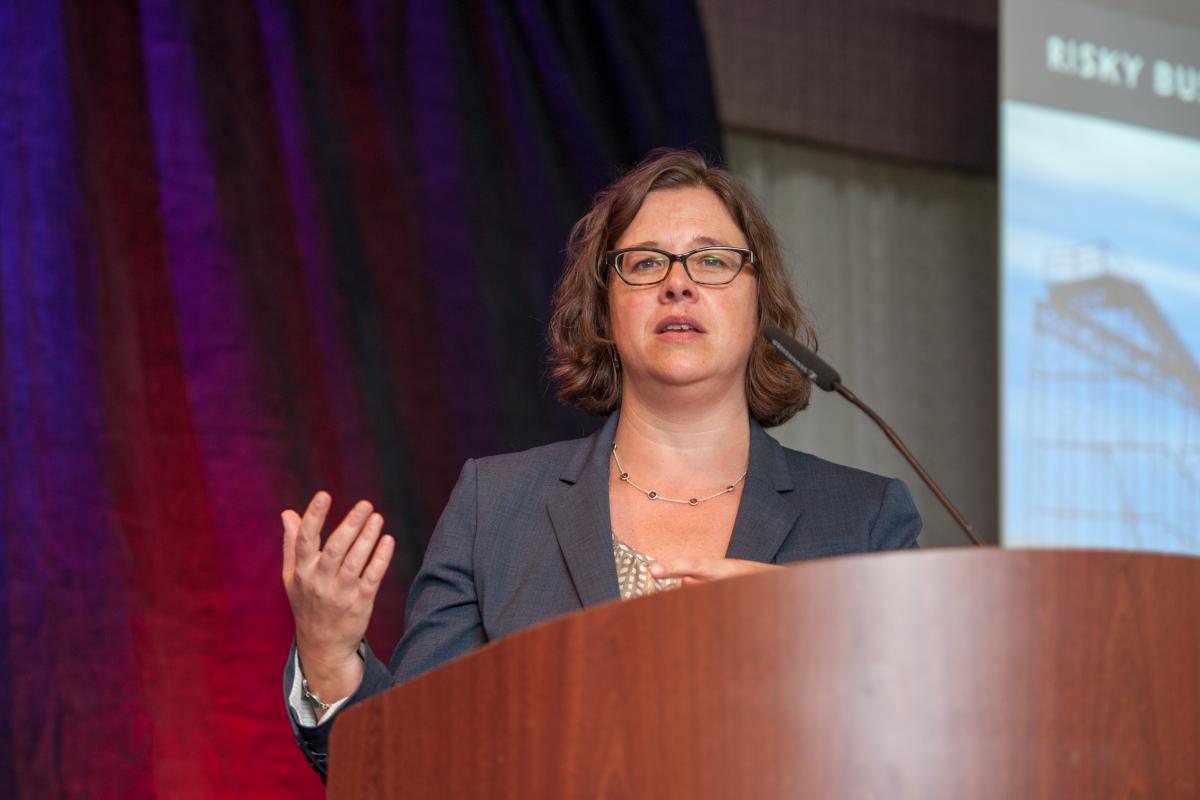 by Kate Gordon, Executive Director, Risky Business Project
by Kate Gordon, Executive Director, Risky Business Project
I grew up in and around universities. As the child of a law professor, I spent time in Buffalo, NY, Madison, WI, and Palo Alto, CA, often doing my homework at the back of lecture halls and empty classrooms. Ultimately I ended up at Wesleyan for my B.A., and then at UC Berkeley for joint degrees in law and city planning, paving the way for my current work on energy and climate policy.
Even with all this exposure to academia, I only fully grasped the role that universities can play in fighting climate change a few weeks ago, when I was lucky enough to spend a day at the annual conference of the American College & University Presidents' Climate Commitment. I was there to talk about the Risky Business Project, an initiative co-chaired by former New York City mayor Mike Bloomberg, former Treasury Secretary Hank Paulson, and long-time investor and climate activist Tom Steyer. The project takes a classic business risk assessment approach to climate change and identifies specific risks facing each region of the U.S. in three major sectors: energy demand, coastal infrastructure, and commodity agriculture. Our research also identified significant impacts on mortality rates and labor productivity from global temperature increases.
One of the most important findings from the Risky Business report is that climate impacts, like many business risks, are extremely local. Along the Eastern Seaboard and Gulf Coast, for instance, the major economic risks are property losses as a result of sea level rise and storm surge. The Midwest, on the other hand, is more likely to see potential crop yield losses and labor productivity decreases from extreme heat. Just as different regions face different risks, individual businesses, institutions, and governments are likely to have different risk responses: from shoring up or “hardening” existing infrastructure, to changing long-term investment strategies so that their supply chains are less vulnerable in the future, to dramatically lowering carbon emissions across their operations. Ultimately, though, addressing climate change will require global action if we are to alter our current risk trajectory.
 It is this interaction between local impacts and global response that makes colleges and universities so perfectly placed to lead the charge on addressing climate change. These institutions are place-based, existing in physical locations to which they have unbreakable ties (try to get University of Miami to move to Michigan!). At the same time, they are responsible for educating leaders who will fan out across the globe. College and university presidents have to address the immediate impacts from extreme weather events – a fact that’s made clear in this amazing video of NYU’s Langone Medical Center going through post-Superstorm Sandy recovery – while also incubating the academics and students who are front lines of climate science, economic modeling, and climate activism. And as investors, through their endowments, these institutions have become a key focus for the divestment/re-investment movement.
It is this interaction between local impacts and global response that makes colleges and universities so perfectly placed to lead the charge on addressing climate change. These institutions are place-based, existing in physical locations to which they have unbreakable ties (try to get University of Miami to move to Michigan!). At the same time, they are responsible for educating leaders who will fan out across the globe. College and university presidents have to address the immediate impacts from extreme weather events – a fact that’s made clear in this amazing video of NYU’s Langone Medical Center going through post-Superstorm Sandy recovery – while also incubating the academics and students who are front lines of climate science, economic modeling, and climate activism. And as investors, through their endowments, these institutions have become a key focus for the divestment/re-investment movement.
As the ACUPCC’s growing membership makes clear, many college and university presidents understand this unique role and are taking concrete steps to address climate risk. They are including more energy and environmental courses in their curricula, funding cutting-edge research, and achieving net-zero energy buildings in some cases. But in the recent words of Stanford president John Hennessy and Harvard president Drew Faust, writing in the Huffington Post: “Those of us in the academy should be asking ourselves what more can we do to confront one of the most urgent and consequential challenges facing our civilization.” (Emphasis mine.)
The truth is that there is more to be done. To truly lead in the fight against climate change, and to most effectively manage their own risks, college and university presidents should be thinking outside the box, breaking the boundaries of traditional actions, and taking a truly interdisciplinary approach to climate action. That means making climate risk a core part not only of the environmental curriculum, but of mainstream economics and business courses. It means lowering emissions in campus buildings and operations, but also aggressively promoting clean energy practices and policies in the cities and states in which their campuses are located – and where they often own large swaths of real estate. And it means taking a hard look at both capital investments and endowments, to ensure these are structured to minimize the university’s vulnerability to climate risk over the long term.
Our colleges and universities are already enjoying a new era of climate scholarship, one revolutionized by cloud computing, crowd sourcing, and interdisciplinary thinking. It’s time they entered a new era of climate action as well.
-Summit photos: © Jennifer White Photography

Add new comment